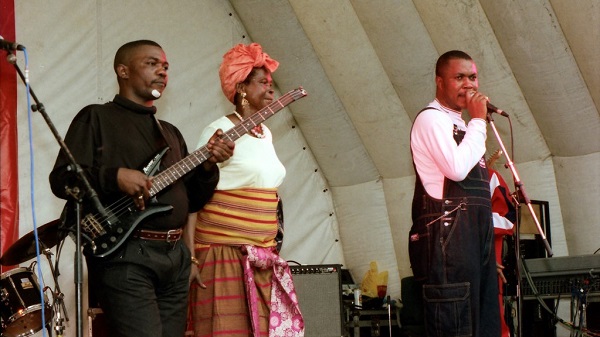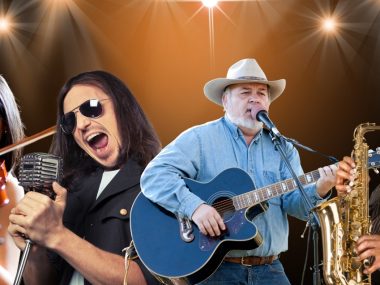With over 1.3 billion people spanned across 54 countries and more than 3,000 tribes, the African continent offers an extremely diverse taste of music that influenced some of the world’s most popular genres!
If you want to know more about the types of African music from all over the continent, you’re in for a treat!
In today’s article, I’ll walk you through 17 different types of popular music that you can enjoy from humanity’s motherland. Let’s hop in!
1. Semba
Kicking off the list with one of the most popular music genres in Africa that have been popular since the 20th century. The music genre comes from Angola and is still commonly practiced to this day.
The music is fast-paced, highly energetic, and accompanied by recognizable dance movements, such as touching bellies, which is known as “massemba”, hence the name of the music type.
Multiple Angolan singers have made Semba hits that cemented the place of the genre among world music.
2. Mbalax
Mbalax, also known as “Mbalakh”, is arguably the most popular music style in Senegal and Gambia.
The music genre originates from the rite ceremonies and celebrations of the Serer’s West African ethnic group.
The genre was born in the 1970s due to the amalgamation of western elements of rhumba, jazz, soul, and rock music with the traditional music of the region.
Youssou N’Dour’s Super Etoiles musical group were the pioneers of the genre, utilizing Tama drummings and sabar polyrhythms in the process.
3. Highlife
Highlife is a music genre that is widely popular in almost all English-speaking countries of West Africa.
It originated throughout the first decades of the 1900s in present-day Ghana when it was a part of the British Empire.
Highlife became initially popular among Nigerian Ndigbo people in the 60s. The music has a jazzy horn vibe with multiple guitars playing. Recently highlife has developed into adding more uptempo music and synth-driven sounds.

4. Soukous
Soukous comes from the French word “secousse”, which means “jolt” or “shock”. This can give you an insight into the music genre!
The soukous is a music genre and dance that originates from Zaire, currently known as “The Democratic Republic of Congo”.
The main influence behind soukous is Congolese adaptations of rhumba in the late 60s. However, soukous music didn’t become popular until the late 80s when the music got a faster tempo with a long dance sequence.
A lot of modern-day Congolese music is directly derived or took inspiration from soukous, such as Koffi Olimide’s “Tcha Tcho”, which is a more melancholic version of soukous.
5. Mbaqanga
Mbaqanga originated in South African rural Zulu tribes in the early 1960s. The music style directly translates to “cornmeal porridge” or “dumplings”, as a way to describe the genre as “homemade”.
It comes from the fusion of ancient African music and dance genres, which are Raucous and Jive.
The music is dubbed as a combination between groaning bass of South African jazz and reggae with Highlife and traditional dances of South African tribes.
In addition to South Africa, the music genre is also popular in English-speaking African countries like Nigeria.
6. Zilin
Zilin comes originally from the traditional vocal songs of old Benin tribes. The music is deeply intertwined with Benin’s long history with the Voodoo religion, which is why a lot of zilin’s music takes influence from these chants.
7. Rababah
The Rababah or Rebab is one of the oldest string musical instruments known to mankind, which has roots dating back to Ancient Egyptians, Arabs, Romans, Persians as well as East and West African countries.
The melodies or rababah is unique enough to form a music genre on their own, which is widely played in the southern regions of Egypt to this day.
Traditional rababah music originated in Egypt by Sudanese immigrants and is often accompanied by ballads about chivalry and virtue sang in an epic poetic form.

8. Makossa
Makossa is an urban dance and music style that originated in Cameroon. The style has a similar tone to the more popular soukous style although they both originated at the same period in the 1960s, so they are not necessarily derived from each other.
The true influence behind the makossa genre is the Douala dance, which is called “kossa”, hence the name of the music style.
The makossa music relies heavily on using potent bass tunes and includes more energetic and prominent brass.
The music developed throughout the decades and has been popular all over Africa during the 80s.
9. Funana
Funana is a popular music and dance style that originated in Cape Verde. Similar to most of the music genres in the Sub-Saharan area, this one is accordion-based music and has quite a variable tempo and a characteristic 2-beat rhythm.
The Funana music and dance are structured through multiple sections that alternate and refrain, which makes the music genre notably monotonic when compared to other African music styles.
10. Chimurenga
Chimurenga is a popular music genre with Zimbabwean origins. The most notable name in the music genre is Thomas Mapfumo, which introduced the Chimurenga melodies to the world with his band, the Blacks Unlimited.
The music utilizes the unique cyclic melody with rhythm and chiming quality of the mbira, a sacred instrument that is originally used in bird ritual ceremonies. However, electric instruments were also used for the genre.
A lot of Chimurenga classics are about the struggles of liberation, social justice, and human rights.
11. Benga
Benga is a popular African music genre that evolved in Kenya’s capital, Nairobi, between the late 1940s and late 1960s.
Like many music genres of the region, benga music is a fusion between the music of Luo people of Kenya and influences from music around Africa and the world, including Cuba, South Africa, Congo, and more.
Many of the benga songs use the Nyatiti, which is an ancient musical instrument used by the Luo people during their rites and spiritual practices.

12. African Jazz
African Jazz started through performances in nightclubs and similar venues, simultaneously with western jazz in the U.S.
The African Jazz scene also evolved into multiple subgenres, such as Cape Jazz, which is still popular in the most southern regions of Africa, and Marabi, which is fairly close to western jazz and often played in bars known as “shebeens”.
13. Palm Wine
Palm Wine music is popular in West Africa and Sierra Leone, although it goes there by the name “Maringa”.
The music dates back to the times where the first Portuguese sailors arrived in the area, bringing multiple musical instruments and introducing them to the region.
Native African musicians started combining guitar tones with bottle percussion to produce lifting and light music that’s fit for gatherings.
While playing the music, attendants would drink a palm wine, which is a beer alternative made from the fermented sap of palm trees, which is where the genre has got its name.
14. Rai
Rai, also written as Raï, is one of the most notable folk music that is alive today in North Africa, especially in Algeria, and to a lesser extent in Morocco and Tunis.
Singers of rai are usually called “cheb”, which means “young man” in Arabic. The name of the genre typically describes the “youth vibe” of the musical genre that uses a unique pattern of melodies and instruments, especially accordions.
The musical style originated in the Algerian city of Oran, which was a melting pot for a variety of cultures during the World War I era in the 1920s.
The musical genre has its devoted fans to this day even outside of Algeria, including France, Egypt, and Asian-Arab countries.
The most popular Rai singer is “Cheb Khaled”, which is often dubbed as “The King of Rai” and has many of his songs played in Hollywood films.
15. Juju
Juju is a popular style of African music that originated in Nigeria. It has got its name from the Yoruba word “Jiju”, which means “something being thrown out”, and not from Juju witchcraft as some people might think.
The urban music style has been popularized since the 1920s. Throughout the years, juju music has been an inspiration for many other forms of African music, such as afrobeat, which became very popular even outside Nigeria.

16. Gnawa
Gnawa is a form of ethnic pop music that comes from the Sub-Saharan desert regions as well as Morocco.
The Gnawa music is still a traditional type of music in these regions, with performances that combine traditional music and rhythms with ritual poetry and using a unique form of a traditional banjo, called gimbri.
Outside of Africa, the music is fairly popular in European countries with Morrocoan minorities, such as France, Belgium, and the Netherlands.
17. Taarab
Taarab is a music genre that’s widely popular in all countries of North Africa, especially countries with Arab origins and the Middle East.
You’d also come across the classical music style in a variety of East African countries, such as Zanzibar, Tanzania, and Kenya. Taarab in Arabic means “the Joy of listening to music”.
Taarab often use a variety of oriental and western musical instruments, such as the kanun, oud, as well as violins, and cello in an orchestral setting.







